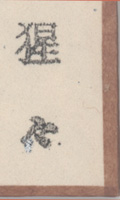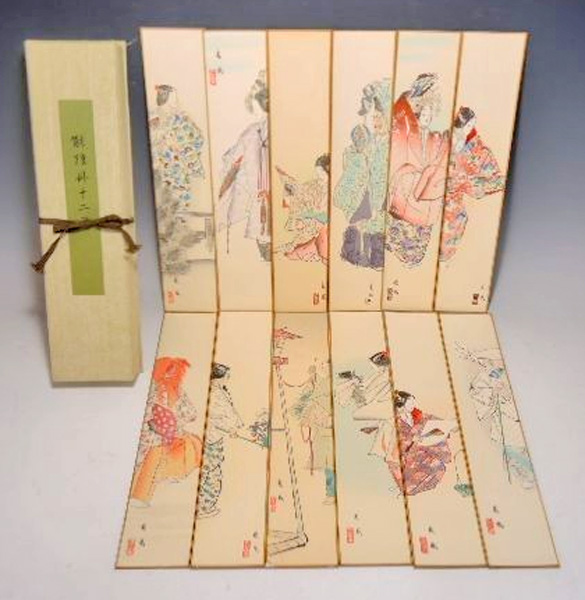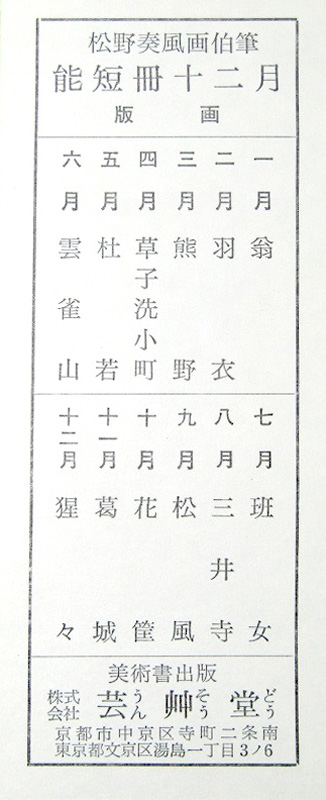About This Print and Twelve Months of Noh Tanzaku
For another print in this collection depicting this play see Shōjō (December) from the series Twelve Months of Noh Pictures.
Twelve Months of Noh Tanzaku
From an undated set of twelve prints depicting twelve Noh plays, one play for each month, published by Unsōdō Publishing. This set likely preceded the set of prints with a similar name Twelve Months of Noh Pictures designed by Matsuno Sōfū (1899-1963) and his son Matsuno Hideyo (1936-2002). The print set, as stated in its title, was designed in the tanzaku format, a long and narrow pillar format originally used for poem cards and offerings. Each print presents the main character in a noh play in a truncated profile, allowing the viewer to complete the picture for each well known play.
In this set, reference image shown below, each print is mounted on a stiff board, the verso of which contains the prints title. The colophon for the set is shown below.
松野奏風画伯筆 能短冊十二月 版画
Twelve Months of Noh Tanzaku by Matsuno Sofu, Woodblock Prints
一月 翁; 二月 羽衣; 三月 熊野; 四月 草子洗小町; 五月 杜若; 六月 雲雀山; 七月 班女; 八月 三井寺;九月 松風; 十月 花筐; 十一月 葛城; 十二月 猩々
January Okina; February Hagoromo; March Yuya; April Sōshi Arai Komachi; May Kakitsubata; June Hibariyama; July Hanjo; August Miidera; September Matsukaze; October Hanagatami; November Kazuraki; December Shōjō
美術書出版
株式会社 芸艸堂
京都市中京区寺町二条南
東京都文京区湯島一丁目 3-6
Art Book Publishing
Unsōdō Public Company
Kyoto City address
Tokyo address
The Play - Shōjō
Source: A Guide to No, P.G. O'Neill, Hinoki Shoten, 1929, p. 163-164.
Characters:Waki - Kō-fū, a wine dealerShite - an elf-like creature
A man named Kō-fū, living in ancient China, explains that by following a dream which he had in reward for his filial piety and which told him to sell wine in the market, he has become a prosperous man. At the market, there is one particular person who always comes to him to buy wine, and since he told the dealer that he is an elf living in the sea, the man has come down to the estuary to wait for him to appear. When he does so, red-faced from his drinking, the man serves him with wine and watches him dance. The elf, in return, gives him a well of wine which never runs dry.
Source: A Guide to No, P.G. O'Neill, Hinoki Shoten, 1929, p. 163-164.
Characters:
Waki - Kō-fū, a wine dealer
Shite - an elf-like creature
A man named Kō-fū, living in ancient China, explains that by following a dream which he had in reward for his filial piety and which told him to sell wine in the market, he has become a prosperous man. At the market, there is one particular person who always comes to him to buy wine, and since he told the dealer that he is an elf living in the sea, the man has come down to the estuary to wait for him to appear. When he does so, red-faced from his drinking, the man serves him with wine and watches him dance. The elf, in return, gives him a well of wine which never runs dry.
Source: website of the Noh.com http://www.the-noh.com/en/plays/data/program_053.htmlThis drama is filled with a celebratory atmosphere. It is often performed with Kogaki or special staging features, whose performances are called “Midare” or “Shōjō-midare”. When this piece is performed in these special styles, the shite or protagonist performs a unique dance, “midare” instead of chū-no-mai. In this case, this drama is called “Midare” or “Shōjō-midare”, not “Shōjō”, in the program. “Midare” and “Shōjō-midare” are categorized as one of the hiraki-mono, the group of Noh dramas which demand highly advanced technique and psychological maturity of the performers. It therefore requires special training to perform. Other than this unique dance, the other special staging features include funny ones, such as showing wine jars and bringing many Shōjō on the stage.
The story is simple, therefore the focal point is not in the storyline but rather in the expression of the celebrating, auspicious atmosphere. Please enjoy the dance of joy of Shōjō, a winsome monster with a red face.
1 Small vertical poem cards, approximately 36cm long x 6cm wide that may be decorated with colored designs, sprinkled with cut gold, silver or mica or covered with silk. The origins of this form may be connected to small slips of paper used for divining in ancient times. Another possible origin of tanzaku comes from the Heian period, when small rectangular pieces of paper, on which one poem was written, were used for poetry anthologies. The earliest extant examples from the 14c are of waka 和歌 poems on tanzaku white with no decoration. It was during the Muromachi period that tanzaku became highly decorated with cloud patterns overlaid with cut pieces of gold and silver. [source: Japanese Architecture and Art Net Users System.]
Print Details
| IHL Catalog | #2405 |
| Title | Shōjō (December) 猩々(十二月) title printed verso |
| Series/Album | Twelve Months of Noh Tanzaku 能短冊十二月 Noh tanzaku jūnikagetsu |
| Artist | Matsuno Sōfū (1899-1963) |
| Signature |  |
| Seal | 枩埜崇 Matsunosō [last character in seal unconfirmed] |
| Date | unknown, but likely 1950-early 1960s |
| Edition | unknown |
| Publisher | Unsōdō Publishing 芸艸堂 版 |
| Carver | unknown |
| Printer | unknown |
| Impression | excellent |
| Colors | excellent |
| Condition | excellent |
| Genre | nishiki-e; Nōgaku zue [Noh play picture] |
| Miscellaneous | |
| Format | tanzaku |
| H x W Paper | 14 1/4 x 2 7/8 in. (36.2 x 7.3 cm) |
| Collections This Print | |
| Reference Literature |
12/7/2020 created




